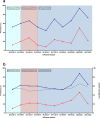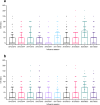Prevalence of Influenza B/Yamagata Viruses From Season 2012/2013 to 2021/2022 in Italy as an Indication of a Potential Lineage Extinction
- PMID: 39257041
- PMCID: PMC11387461
- DOI: 10.1111/irv.13359
Prevalence of Influenza B/Yamagata Viruses From Season 2012/2013 to 2021/2022 in Italy as an Indication of a Potential Lineage Extinction
Abstract
Background: Influenza B/Yamagata viruses exhibited weak antigenic selection in recent years, reducing their prevalence over time and requiring no update of the vaccine component since 2015. To date, no B/Yamagata viruses have been isolated or sequenced since March 2020.
Methods: The antibody prevalence against the current B/Yamagata vaccine strain in Italy was investigated: For each influenza season from 2012/2013 to 2021/2022, 100 human serum samples were tested by haemagglutination inhibition (HAI) assay against the vaccine strain B/Phuket/3073/2013. In addition, the sequences of 156 B/Yamagata strains isolated during the influenza surveillance activities were selected for analysis of the haemagglutinin genome segment.
Results: About 61.9% of the human samples showed HAI antibodies, and 21.7% had protective antibody levels. The prevalence of antibodies at protective levels in the seasons between the isolation of the strain and its inclusion in the vaccine was between 11% and 25%, with no significant changes observed in subsequent years. A significant increase was observed in the 2020/2021 season, in line with the increase in influenza vaccine uptake during the pandemic. Sequence analysis showed that from 2014/2015 season onward, all B/Yamagata strains circulating in Italy were closely related to the B/Phuket/2013 vaccine strain, showing only limited amino acid variation.
Conclusions: A consistent prevalence of antibodies to the current B/Yamagata vaccine strain in the general population was observed. The prolonged use of a well-matched influenza vaccine and a low antigenic diversity of B/Yamagata viruses may have facilitated a strong reduction in B/Yamagata circulation, potentially contributing to the disappearance of this lineage.
Keywords: Yamagata lineage; humoral immunity; influenza B virus.
© 2024 The Author(s). Influenza and Other Respiratory Viruses published by John Wiley & Sons Ltd.
Conflict of interest statement
A.M. is employed by VisMederi srl. E.M. is founder and Chief Scientific Officer of VisMederi srl and VisMederi Research srl. C.M.T. is an external consultant of VisMederi srl and VisMederi Research srl. O.K. is an external consultant of VisMederi srl.
Figures





References
-
- World Health Organization , “Vaccines against Influenza: WHO Position Paper ‐ May 2022,” Weekly Epidemiological Record 19, no. 97 (2022): 185–208.
-
- Caini S., Meijer A., Nunes M. C., et al., Is Influenza B/Yamagata Extinct and What Public Health Implications Could This Have? An Updated Literature Review and Comprehensive Assessment of Global Surveillance Databases, medRxiv, (2023): 2023.09.25.23296068.
MeSH terms
Substances
LinkOut - more resources
Full Text Sources
Medical

